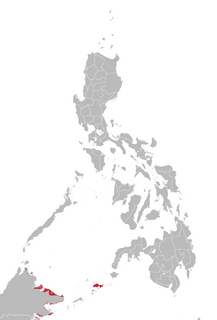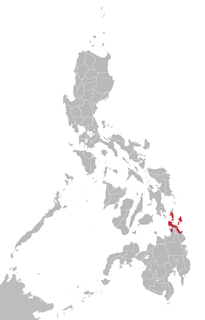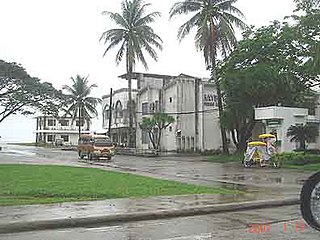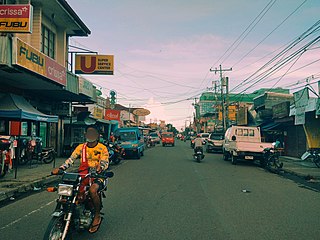Related Research Articles

The Visayas, or the Visayan Islands, are one of the three principal geographical divisions of the Philippines, along with Luzon and Mindanao. Located in the central part of the archipelago, it consists of several islands, primarily surrounding the Visayan Sea, although the Visayas are also considered the northeast extremity of the entire Sulu Sea. Its inhabitants are predominantly the Visayan peoples.

Leyte is a province in the Philippines located in the Eastern Visayas region, occupying the northern three-quarters of Leyte Island. Its capital is the city of Tacloban, administered independently from the province. Leyte is situated west of Samar Island, north of Southern Leyte and south of Biliran. To the west across the Camotes Sea is the province of Cebu.

Cebuano, also referred to by most of its speakers simply and generically as Binisaya, is an Austronesian language, spoken in the southern Philippines. Specifically, it flourishes in Central Visayas, western parts of Eastern Visayas and on most of Mindanao. It originated on the island of Cebu, and now is spoken primarily by various Visayan ethnolinguistic groups who are native to those areas, primarily the Cebuanos. While Tagalog has the largest number of native speakers among the languages of the Philippines today, Cebuano had the largest native-language-speaking population in the Philippines from the 1950s until about the 1980s. It is by far the most widely spoken of the Bisayan languages.

Abuyog, officially the Municipality of Abuyog, is a 1st class municipality in the province of Leyte, Philippines. According to the 2020 census, it has a population of 61,216 people.

There are some 120 to 187 languages spoken in the Philippines, depending on the method of classification. Almost all are Malayo-Polynesian languages native to the archipelago. A number of Spanish-influenced creole varieties generally called Chavacano are also spoken in certain communities. The 1987 constitution designates Filipino, a standardized version of Tagalog, as the national language and an official language along with English. Filipino is regulated by Komisyon sa Wikang Filipino and serves as a lingua franca used by Filipinos of various ethnolinguistic backgrounds.

The Bisayan languages or the Visayan languages are a subgroup of the Austronesian languages spoken in the Philippines. They are most closely related to Tagalog and the Bikol languages, all of which are part of the Central Philippine languages. Most Bisayan languages are spoken in the whole Visayas section of the country, but they are also spoken in the southern part of the Bicol Region, islands south of Luzon, such as those that make up Romblon, most of the areas of Mindanao and the province of Sulu located southwest of Mindanao. Some residents of Metro Manila also speak one of the Bisayan languages.

Tausug is an Austronesian language spoken in the province of Sulu in the Philippines and in the eastern area of the state of Sabah, Malaysia, by the Tausūg people. It is widely spoken in the Sulu Archipelago, the Zamboanga Peninsula, southern Palawan, and Malaysia.
The Central Philippine languages are the most geographically widespread demonstrated group of languages in the Philippines, being spoken in southern Luzon, Visayas, Mindanao, and Sulu. They are also the most populous, including Tagalog, Bikol, and the major Visayan languages Cebuano, Hiligaynon, Waray, Kinaray-a, and Tausug, with some forty languages all together.

Surigaonon is an Austronesian language spoken by Surigaonon people. As a regional Philippine language, it is spoken in the province of Surigao del Norte, Dinagat Islands, Surigao del Sur, and some portions of Agusan del Norte, especially the towns near the Mainit Lake, Agusan del Sur and Davao Oriental.

Poro, officially the Municipality of Poro, is a 4th class municipality in the province of Cebu, Philippines. According to the 2020 census, it has a population of 26,232 people.

Tudela, officially the Municipality of Tudela, is a 5th class municipality in the province of Cebu, Philippines. According to the 2020 census, it has a population of 11,304 people.

San Juan, officially the Municipality of San Juan, is a 5th class municipality in the province of Southern Leyte, Philippines. According to the 2020 census, it has a population of 14,912 people.

Baybay, officially the City of Baybay, is a 1st class component city in the province of Leyte, Philippines. It has a population of 111,848 people.

Carigara, officially the Municipality of Carigara, is a 2nd class municipality in the province of Leyte, Philippines. According to the 2020 census, it has a population of 54,656 people.

Norberto Romuáldez y López was a Philippine writer, politician, jurist, and statesman. He was the first Lopez-Romuáldez to attain national prominence, and is deemed the "Father of the Law on the National Language". He was the eldest son of Doña Trinidad Lopez-Romualdez, the Romualdez grand matriarch, and uncle of First Lady of the Philippines Imelda Romualdez Marcos, the daughter of his youngest brother Vicente Orestes Lopez Romualdez.
The Waray people are a subgroup of the larger ethnolingustic group Bisaya people, who constitute the largest Filipino ethnolinguistic group in the country. Their primary language is the Waray language, an Austronesian language native to the islands of Samar, Leyte and Biliran, which together comprise the Eastern Visayas Region of the Philippines. Waray people inhabit the most part of Samar where they are called Samareños/Samarnons, the northern part of the island of Leyte where they are called Leyteños, and the island of Biliran. On Leyte island, the Waray people occupy the northern part of the island, separated from the Cebuano language-speaking Leyteños by a mountain range in the middle of the island.

The Cebuano people are the largest subgroup of the larger ethnolingustic group Bisaya, who constitute the largest Filipino ethnolinguistic group in the country. Their primary language is the Cebuano language, an Austronesian language. They originated in the province of Cebu in the region of Central Visayas, but then later spread out to other places in the Philippines, such as Siquijor, Bohol, Negros Oriental, southwestern Leyte, western Samar, Masbate, and large parts of Mindanao. It may also refer to the ethnic group who speak the same language as their native tongue in different parts of the archipelago. The term Cebuano also refers to the demonym of permanent residents in Cebu island regardless of ethnicity.
The Kabalian (Cabalian) language, Kinabalian, is spoken in the municipality of San Juan in the province of Southern Leyte in the Philippines. It is closely related to Waray-Waray.

Waray is an Austronesian language and the fifth-most-spoken native regional language of the Philippines, native to Eastern Visayas. It is the native language of the Waray people and second language of the Abaknon people of Capul, Northern Samar, and some Cebuano-speaking peoples of western and southern parts of Leyte island. It is the third most spoken language among the Bisayan languages, only behind Cebuano and Hiligaynon.

Eastern Visayas is an administrative region in the Philippines, designated as Region VIII. It consists of three main islands, Samar, Leyte and Biliran. The region has six provinces, one independent city and one highly urbanized city namely, Biliran, Leyte, Northern Samar, Samar, Eastern Samar, Southern Leyte, Ormoc and Tacloban. The highly urbanized city of Tacloban is the sole regional center. These provinces and cities occupy the easternmost islands of the Visayas group of islands.
References
- ↑ Baybay at Ethnologue (18th ed., 2015)
- 1 2 3 Rubino, Carl (2005). "Utudnon, an Undescribed Language of Leyte" (PDF). In Liao, Hsiu-chuan; Rubino, Carl R. (eds.). Current Issues in Philippine Linguistics and Anthropology: Parangal kay Lawrence A. Reid. Manila, Philippines: Linguistic Society of the Philippines and SIL Philippines. pp. 306–336.
- ↑ ISO 639-3 Registration Authority (2009). "Request for New Language Code Element in ISO 639-3" (PDF). request number 2009-083.